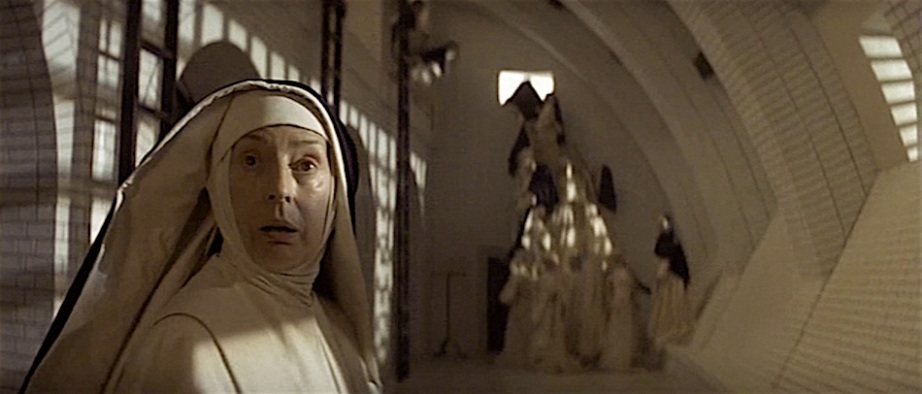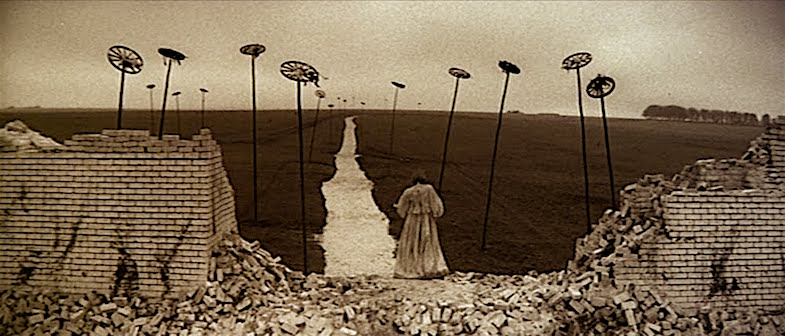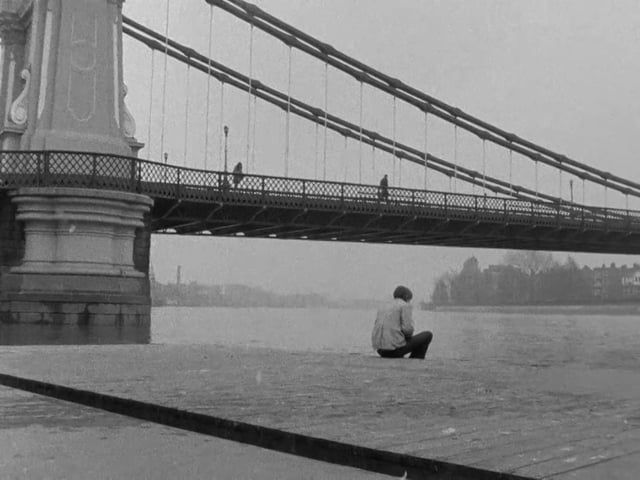
Uh, oh. Trouble is coming from all sides as Ken Russell takes British Film into the 1970’s. Despite on-going demand, Time Warner still refuses to allow us to take a full-on second look back. Britain’s most infamous film actually belongs to a United States based corporation. The Devils Ken Russell, 1971 Cinematography | David Watkin
When one thinks of 1960’s Film Art, the mind does not immediately jump to thoughts of British cinema. Most of us think of France’s La Nouvelle Vague, Germany’s Neuer Deutsche Film, Italy’s NeoRealism film movement, The Japanese New Wave or The Polish New Wave from which Britain did snatch Roman Polanski. Certainly there were groundbreaking British films that caught the spirit of London’s Swinging 60’s Era, but many of these films have aged rather poorly. Just think of Petulia, Morgan!, Darling, Billy Liar or Georgy Girl. If honest, what really still works about these films is related to a time capsule interest. Many of these British films are quite valid (think A Taste of Honey, This Sporting Life, Room At The Top, A Hard Day’s Night, Seance on a Wet Afternoon, Performance ) but the majority have not held up as well as one might hope.
This is not true across the board. Stanley Kubrick’s British work has only gotten better with time and Michelangelo Antonioni’s visit into Swinging London culture of the time, Blow Up, remains a vital work. However, are these truly British films? It would seem that both of these filmmakers were in a sort of transitionary position. Antonioni was visiting England. Kubrick was still fairly new to British culture.

The great Julie Christie is The Ideal Woman of 1965’s British satire of Swinging London, but the film barely registers beyond nostalgia now. Darling John Schlesinger, 1965 Cinematography | Kenneth Higgins
Most of the iconic British films of the 1960’s are simply limited to nostalgia. Guy Hamilton, Andy Milligan, Lindsay Anderson, Karel Reisz and Lindsay Shonteff are exceptions but much of what they were trying to convey would soon better estimated by the likes of Alan Parker and most especially Mike Leigh. Ken Loach would not truly find his voice until he entered his 50’s in the 1990’s. There was also a good share of attention to The Angry Young Man of the day. Tony Richardson had moments of brilliance but looking back he seemed to have been challenged by what style of film best suited his voice. Richard Lester certainly left a mark, but here again we are slipping into time capsule pop culture moments.
The British New Wave is also largely obscured by the mega-epics of David Lean’s heavily praised, Lawrence of Arabia and Doctor Zhivago are considered to be a cinematic masterpieces. I’ve never been particularly impressed. To be honest, I’ve never made it through Lawrence of Arabia without falling asleep. Carol Reed’s adaptation of the stage musical, Oliver! was another huge British hit of the 1960’s that pushed pass the more reflexive films of the day.
There were two particularly strong and solitary British Film Artists who were finding new methods of cinematic language. Nicolas Roeg would soon move from the cinematographer chair to that of director and change the face of film editing as it was known. Ken Russell’s work for the BBC and his adaptation of Larry Kramer’s adaptation of DH Lawrence’s Women In Love all stand alone and unique in offering new ways of using film to express ideas and to tell stories. And he really stole the anticipated reigns of the film biography when The Music Lovers slammed onto movie screens across the world in 1970.

Ken Russell welcomes us to the 1970’s via way of 16h Century France as “the wife” of a Priest makes her way past the destruction of the Roman-Catholic Church… Gemma Jones The Devils Ken Russell, 1971 Cinematography | David Watkin
As British Film headed into the 1970’s some firm and potent voices formed. Certainly Stanley Kubrick’s A Clock Work Orange is a British Film. All American cultural ideas have fallen off his cinematic map. John Schlesinger pretty much left England for America. Ken Russell defied all expectations with his searing and important 1971 film, The Devils. As it turns out Ken Russell, Nicolas Roeg and Stanley Kubrick were not alone. The thing is some of the new British voices got somehow lost in the mix. Barney Platts-Mills’ may have only made one film in the 1960’s, but it is a powerful entry into British Film History. Three other filmmakers also created work not only ahead of the cultural curve — they challenged it and ran their work close to the edge of the rails.
As we stumble forward toward the third decade of the 21st Century, The British Film Institute has gone deep within the corners of their storage closets to re-release a couple of seldom seen motion pictures that capture 1960’s London in whole new ways. Most of these titles were dusted off, restored, re-released within the UK and issued to DVD/Blu-Ray between 2009 and 2011.

The British Film Festival pulled several legendary but almost forgotten films and re-issued them to DVD/Blu-Ray in 2010 and 2011. These “lost” films of Jack Bond, Jane Arden, Joseph Despins and William Dumaresq teach us that Ken Russell and Stanley Kubrick were not alone in finding new ways to capture stories and ideas for the British Screen.
Two of these four filmmakers were actually Canadian born. Even still, these two ex-pats of Canada artists show no signs of unfamiliarity with the setting of their two crucial films that BFI re-issued several years back for the first time in over 40 years. The other two filmmakers are most certainly British and have cinematic voices which come close to that of Ken Russell and Nicolas Roeg. Like Russell / Roeg, these two British Film Artists were well-versed but often Anti-Intellectual in the way they approached their work. They were far more focused on the visual and the use of film editing. Rebels all, but each were reeling out their rebellion from different core identities. Unlike Ken Russell and Nicolas Roegs’ work of the 1960’s, all four of the other Film Artists will not appeal to a number of people, but it is hard to imagine anyone disputing their importance.
I’m currently exploring the work of a number of British filmmakers who are new to me. I plan on writing more on the art and collaborations of Jane Arden and Jack Bond. The work these two created almost defies terminology, but I’m going to give it my best shot!
But for this post, I want to touch on two films. The first of these two was born out of the mixed theatre and social service ideals of the great Joan Littlewood. “The Mother of Modern Theatre” devoted the second half of her life working with the young people of East London who were lost, without purpose or supervision. These young people were in constant threat of falling prey to all manner of trouble. Her idea was to create a space where these teenagers could be allowed to hang out and “act” out their issues, challenges and ideas. Firmly grounded in the arts but against what she viewed as Elitism of The National Theatre. Her Theatre Royal Stratford East was free of pretension and open to everyone. It was here that Barney Platts-Mills was inspired to scrap together a bit of money to make an amazing little film called Bronco Bullfrog.

Non-actors, Anne Gooding & Del Walker, “play” fictionalized versions of themselves and contemplate their futures.
Bronco Bullfrog
Barney Platts-Mills, 1969
Cinematography | Adam Barker-Mill
Bronco Bullfrog stars non-actors who had been working with each other under the loose guidance of Joan Littlewood. While the plot is deceptively simple, a great deal of information about the grimness of urban decay, lack of parenting and dystopian boredom come through loud and clear. Glam and style-free, this is a study of teenagers floating along without purpose, direction or hope. Interestingly, it is not all gloom and doom. The characters of Bronco Bullfrog start to find their way as the film heads to conclusion. This is a gem of a film that has never received the praise or attention it deserved. As good as this movie is, it can hardly stand-up when positioned next to Joseph Despins and William Dumaresqs’ ultra-strange and unforgettable twisted little movie, Duffer.

A good 6 years before anyone had seen the dark surrealism and humor of David Lynch, this low-budget experimental film serves as welcome warning that the art of filmmaking is about to take an innovative, creative and altogether new turn. Kit Gleave as Duffer Joseph Despins & William Dumaresq, 1971 Cinematography | Jorge Guerra
Joseph Despins and William Dumaresq crafted this weird and entertaining movie on a budget so low it is probably best not to state it. The camera work is surprisingly solid. Actually the cinematography is far more than solid, it is artistically sound. Cinematographer, Jorge Guerra, may not have had the best equipment but he most certainly knew how to use it. The shots are often brilliant.
There is no sound. The narration and voices were recorded by a different cast. It only takes a few minutes before it is clear that the lack of sound was not going to be a deficit. In fact, the creative dubbing actually adds to this film in more ways than one. Comical and often horrifying, the dubbed dialogue serves exceptionally as an aide to the film’s surrealism, dark comedy, menace and horror.

“WoManAmal!!!” Duffer’s junkie gay keeper heaps on the abuse and chronicles it all for underground porn.
William Dumaresq as “Louis-Jack”
Duffer
Joseph Despins & William Dumaresq, 1971
Cinematography | Jorge Guerra
The dubbing actually heightens the discomfort as we watch a young man attempt to reconcile the emotional, physical and sexual abuse of his older junkie boyfriend by engaging in an affair with a female prostitute. Enduring the sort of sadistic torment one seldom sees addressed in film, Despins and Dumaresq were extremely clever in presenting it in very dark comical ways that disturb but never so much that one needs to run for cover. The kind but obviously more than a bit twisted herself, prossie called Your Gracie gives the lost teen some solace while fully utilizing him as a tool.

Erna May as “Your Gracie” is using Kit Gleave’s “Duffer,” but he hopes she is saving his masculinity… Duffer Joseph Despins & William Dumaresq, 1971 Cinematography | Jorge Guerra
As the KINK/BDSM with his male keeper becomes more severe and his trysts with his female lover decrease — Duffer is pulled into his male lover’s Horse addiction and begins to suffer one of the most bizarre psychosomatic delusions I’ve ever seen. The poor kid’s delusions continue to morph into what appears to be a psychotic break. This twisted, funny, unsettling and fascinating experimental film deals with almost every aspect of human cruelty and horror imaginable. And just to amp up Duffer’s already potent cinematic stew, we gradually begin to suspect that our protagonist may not be the most reliable narrator.

Just a bi-sexual boy walking through 1970 Notting Hill either on his way from or toward abuse at the hands of older suitors.
Kit Gleave in his only film role…
Duffer
Joseph Despins & William Dumaresq, 1971
Cinematography | Jorge Guerra
As the film unspools more perversities and jaw-drop moments at break-neck speed, we are constantly given an exceptional examination of 1970’s Notting Hill. You may think you’ve seen urban decay and dystopian-like settings, but Duffer presents an England few of us have seen. Filmed on location and on the very cheap, this is perplexing and truly extraordinary view of the state of things circa 1969-1970. I realize that some of you will be annoyed that I’m grouping this film into the 1960’s British New Wave, but Duffer is clearly set in the 1960’s. This is not the 1970’s.
The film begins with Duffer sitting alone by the water. A pretty young woman pauses as she crosses a bridge far above the handsome boy. As the film whirls to conclusion we find him once again in the same place. It is impossible to not ponder where the film’s reality begins or ends. In fact, there is a distinct possibility that none of it is real. However there are just as many clues that all of what see presented has happened in reality. I’m not dropping a spoiler here, the viewer begins to distrust poor Duffer almost immediately. This is a narrator we are unable to trust. But the most jarring aspect of this film is that it presents itself solidly within the Surrealist Context.

All alone in his thoughts…
Duffer
Joseph Despins & William Dumaresq, 1971
Cinematography | Jorge Guerra
It is important to note that as much as I praise Duffer, it is not for all tastes. While never truly graphic, it is most definitely profane and very perverse. The humor is so dark that many will feel guilty laughing. This is one demented movie. It also features a deeply strange musical score from the composer who gave the world the 1960’s Broadway smash, Hair. Galt McDermot’s score plays like something you would hear in an alternate universe Tin Pan Alley. Just when you think you will only be hearing a piano — a quickly use of electronics starts to grind forward.

“Mind how you go…” No where in Notting Hill is safe!
Duffer
Joseph Despins & William Dumaresq, 1971
Cinematography | Jorge Guerra
Duffer screams out for repeated viewings to understand, to ensure that what you think you’ve just seen was actually shown and for the simple fact that this movie is endlessly entertaining. And trust me, this movie gets under your skin. Once it slips under, it stays there. In addition, something about Duffer seems to be signaling the audience to watch out for David Lynch. Were it not so very British, it could easily be mistaken for something a young David Lynch might have created. Unique, innovative, disturbing, haunting, funny and altogether original, Duffer is a must see lost British Cinematic Treasure.

Well there is nothing quite like watching your lover’s home movies abusing you…
Kit Gleave watches what we can only guess hurt a great deal.
Duffer
Joseph Despins & William Dumaresq, 1971
Cinematography | Jorge Guerra
I honestly found no flaw in Duffer.

Just pulled back into darkness after being “fixed” for activities best kept there…
Duffer
Joseph Despins & William Dumaresq, 1971
Cinematography | Jorge Guerra
I loved this film, but the work of both Jane Arden and Jack Bond really blew me away. Blown out the window and lying on the pavement outside our San Francisco home, the collaborations of Arden and Bond require more than a little thought and meditation. I’m still letting their three films digest, but I’ll be writing about them soon.

Pushing Feminist Agenda, Drug Experimentation, Examination and Destruction of an identity born of societal and cultural domination, Jane Arden & Jack Bond pull us into the dangerous threat of absolute madness…
The Other Side of the Underneath
Jane Arden, 1972
Cinematography | Jack Bond & Aubrey Dewar
Matty Stanfield, 12.23.2015









































































